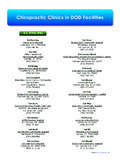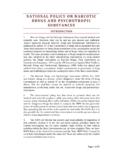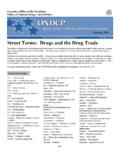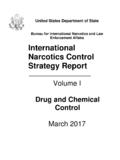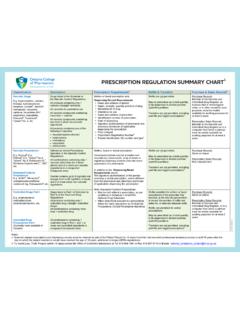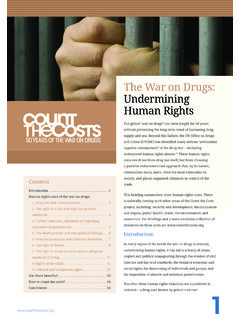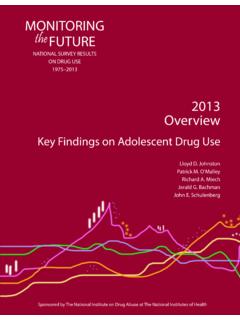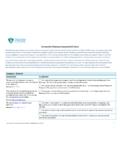Transcription of CHIROPRACTIC - F4CP|Educating the public
1 CHIROPRACTICA SAFER STRATEGYTHAN OPIOIDS Foundation for CHIROPRACTIC Progress 2016 PAGE 2 Foundation for CHIROPRACTIC Progress 2016 ABOUT THE AUTHORS:Laura Carabello, Principal, CPR Strategic Marketing CommunicationsGerard Clum, DC, President Emeritus, Life CHIROPRACTIC College West and Director, The Octagon, Life UniversityWilliam Meeker, DC, MPH, President, Palmer College of CHIROPRACTIC San Jose CampusPAGE 3 Foundation for CHIROPRACTIC Progress 2016 TABLE OF CONTENTSOVERVIEW ..2 THE PRESCRIBER PROBLEM ..4 HOSPITALS CONTRIBUTE TO THE PROBLEM ..6 THE PAIN-PROFIT NEXUS.
2 8 WHERE DO WE GO FROM HERE? ..10 NON-PHARMACOLOGIC APPROACHES THE FIRST OPTIONS IN DEALING WITH CHRONIC PAIN ..12 PREVALENCE OF BACK AND NECK PAIN, HEADACHES AND NEURO-MUSCULOSKELETAL CONDITIONS ..13 CHIROPRACTIC CARE AND THE TRIPLE AIM OF BETTER CLINICAL OUTCOMES, GREATER PATIENT SATISFACTION AND LOWER COST OF CARE ..14 NEVER ONLY OPIOIDS PAIN ACTION ALLIANCE TO IMPLEMENT A NATIONAL STRATEGY (PAINS) ..16 AVAILABILITY OF CHIROPRACTIC CARE IMPROVES THE VALUE OF HEALTH BENEFITS PLANS ..18 AMERICANS WANT AND DESERVE CHIROPRACTIC CARE ..20 END NOTES ..23 PAGE 2 Foundation for CHIROPRACTIC Progress 2016 OVERVIEWThe United States has awakened on every level to the crushing impact of the opioid use/abuse epidemic.
3 Calls have come from the Centers for Disease Control and Prevention (CDC), the Food and Drug Administration (FDA) and the Institute of Medicine (IOM) for a shift away from opioid use toward non-pharmacologic approaches to address chronic important non-pharmacologic approach in helping to solve this crisis is CHIROPRACTIC discussion offers greater understanding of the scope of the opioid situation, the elements that have contributed to it and an approach that emphasizes non-pharmacologic care. Collectively, we must begin to extricate ourselves from our current ineffective, dangerous and often fatal use of opiate drugs and the abuse of these products, has become the story of the day in the popular press -- as well as in the scientific literature.
4 In the process, pain management is finally getting the attention it deserves. The media fanfare surrounding this subject has finally caused the consumer most affected to raise awareness as never before, and will perhaps help to curb the demand for these devastating are being bombarded daily with grim news about drug abuse, physician overprescribing of pain medications, both in-office and at hospital emergency rooms, and the shocking realities of this nationwide drug use catastrophe. The absence of clinical logic and effectiveness for opiate use in the vast majority of settings, the real and present dangers of opiate use and the prescription practices of physicians have been called into question from every corner of health care.
5 When combined with the relentless pursuit of financial gain, these circumstances are magnified many times over by the nation s drug manufacturers. The dire predictions of an epidemic drug problem in the homes of countless average Americans have come to fruition. The data speaks for itself. Overdose deaths involving prescription opioids have quadrupled since 1999,1 as have sales of these prescription From 1999 to 2014, more than 165,000 people --- three times the military deaths during the twenty years of the Vietnam War -- have died in the from overdoses related to prescription PAGE 3 Foundation for CHIROPRACTIC Progress 2016 Today, at least half of all opioid overdose deaths involve a prescribed In 2014, more than 14,000 people died from overdoses involving these drugs, with the most commonly overdosed opioids -- Methadone, Oxycodone (such as OxyContin )
6 , and Hydrocodone (such as Vicodin ) -- resulting in death. Regrettably, overdose deaths resulting from opioid abuse have risen sharply in every county of every state across the country, reaching a new peak in 2014: 28,647 people, or 78 people per day -- more than three people per hour. There are two basic categories of opiate overdose:5 Illegal cheap and abundant heroin and other street drugs, the result of underworld and criminal distribution; and Legal -- responsible for almost double the number of overdose deaths: prescriptions fueled by physicians and the pharmaceutical industry. This may be a meaningless distinction in light of the fact that opiate overdoses in the are now a public health catastrophe and are finally getting the attention they deserve.
7 President Obama quite remarkably said that the opiate epidemic is as great a threat as , the newest estimates on the cost of opioid abuse to employers is estimated at $18 billion in sick days, lost productivity and medical expenses. According to a study from health information firm Castlight Health, employers are paying for one-third of opioid prescriptions that end up being abused. Patients who were given more than a 90-day supply and received a prescription from one or more providers were defined as having opioid abuse. 6 DEFINING OPIOIDS Opioids are a class of drugs that include the illicit drug heroin as well as the licit (legal) prescription pain-relievers oxycodone, hydrocodone, codeine, morphine, fentanyl and others.
8 Opioids are chemically related and interact with opioid receptors on nerve cells in the brain and nervous system to produce pleasurable effects and relieve pain. Addiction is a primary, chronic and relapsing brain disease characterized by an individual pathologically pursuing reward and/or relief by substance use and other behaviors. Of the million Americans age 12 or older that had a substance use disorder in 2014, million had a substance abuse disorder involving prescription pain relievers and 586,000 had a substance abuse disorder involving heroin. It is estimated that 23 percent of individuals who use heroin develop opioid : American Society of Addiction Medicine.
9 PAGE 4 Foundation for CHIROPRACTIC Progress 2016 THE PRESCRIBER PROBLEMIn their quest to meet patient need and demand for chronic pain relief, American doctors are often forced by consumer demands and practice challenges to prescribe and over prescribe narcotic painkillers. Their training and experience have not focused on alternative treatment options, until now. According to a National Safety Council (NSC) 2016 Survey: 99 percent of medical doctors prescribe highly-addictive opioids and for longer than the three-day period recommended by the CDC. 7 The venerable Wall Street Journal went as far as referring to prescribing doctors as.
10 The enablers of an earlier generation of American pain-pill abuse. 8 When the NSC released these results on the heels of the CDC guidelines for treating chronic pain, 23 percent of doctors said they prescribe at least a month s worth of opioids. PAGE 5 Foundation for CHIROPRACTIC Progress 2016 Additionally, 74 percent of doctors incorrectly believe morphine and oxycodone, both opioids, are the most effective ways to treat pain. Furthermore, the problem has reached the point where painkillers with high addictive potential, which include commonly prescribed drugs such as OxyContin, Percocet and Vicodin, now account for more drug overdose deaths than heroin and cocaine combined.
